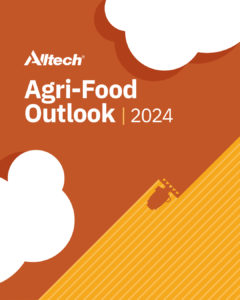 Global animal feed production remained steady in 2023 at 1.29 billion metric tons (BMT), a slight decrease from 2022, according to the Alltech 2024 Agri-Food Outlook annual survey, now in its 13th year, which includes data from 142 countries and more than 27,000 feed mills.
Global animal feed production remained steady in 2023 at 1.29 billion metric tons (BMT), a slight decrease from 2022, according to the Alltech 2024 Agri-Food Outlook annual survey, now in its 13th year, which includes data from 142 countries and more than 27,000 feed mills.
The overall lower demand for feed was due, in part, to the more efficient use of feed made possible by intensive production systems that focus on using animal nutrition, farm management and other technologies to lower feed intake while producing the same amount of protein, or more. A slowdown in the overall production of animal protein, in response to tight margins experienced by many feed and animal protein companies, also contributed to lower feed demand. Changing consumption patterns caused by inflation and dietary trends, higher production costs and geopolitical tensions also influenced feed production in 2023.
According to the survey, the top 10 feed-producing countries, which produce over 63% of the world’s production, are China (262.71 MMT), the U.S. (238.09 MMT), Brazil (83.32 MMT), India (52.83 MMT), Mexico (40.42 MMT), Russia (35.46 MMT), Spain (27.53 MMT), Vietnam (24.15 MMT), Japan (23.94 MMT) and Türkiye (23.37 MMT). Nearly half of the world’s global feed production is concentrated in China, the U.S., Brazil and India.
The survey also found a decrease in feed production for 2023 in pigs, dairy, beef, aquaculture and equine feed, with pet and broiler feed higher and feed for layers nearly steady.
